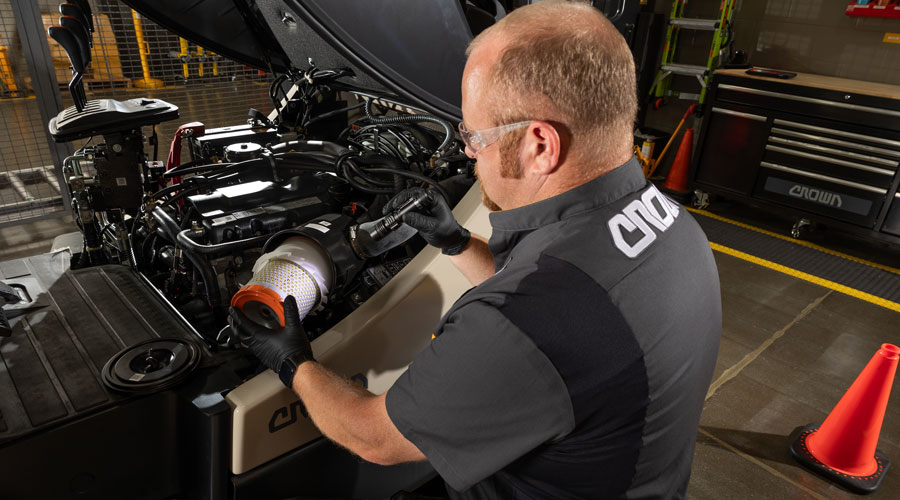Reduce Unexpected Downtime with Planned Maintenance

Choosing the right forklift maintenance plan can be tricky, because of the variety and number of options available. Some facilities require a service call on an almost daily basis, depending on fleet size, the application, the operational schedule, location and maintenance requirements. While most of us, individually, wouldn’t want to have such frequent content with our auto mechanic, regular forklift maintenance is critical to the success of the operation
The functionality of material handling equipment can also affect the operator’s comfort and productivity. While these reasons alone may be motivation enough for regular planned maintenance, it is sometimes delayed because the operation is “too busy” or is experiencing “peak” season. Some customers choose to forego a planned maintenance plan altogether, hoping to maintain the equipment in house and on their own schedule, only to discover that having complete control over the decision can make it even easier to delay critical maintenance when it comes to choosing between service time and work time.
Help Protect Your Bottom Line
While the perceived flexibility of self-service forklift maintenance can be tempting, your service provider can provide you with more options than you might realize, whether it’s the breadth of the maintenance plan, available budget, or even a schedule to fit your operation. Don’t think of maintenance as a necessary evil, but as an enabler that increases runtime, boosts productivity and extends product life. When completed properly and regularly, planned maintenance can actually decrease the total cost of ownership on your equipment by enabling more uptime and minimizing unexpected disruptions.
Imagine, for example, during a planned maintenance inspection, your service technician checks the oil level in the drive unit and finds that it’s low. The technician adds oil to fill the drive unit during the planned maintenance and the issue is taken care of. Because the planned maintenance was completed, a potential issue was noticed and rectified, conveniently and efficiently, essentially costing the price of the planned maintenance.
If planned maintenance was not being completed, the drive unit oil level may have gone unnoticed for an extended period of time, inevitably causing the drive unit to run out of oil which may cause a bearing to fail, requiring the drive unit to be replaced. Then, what follows could consist of a service call charge, labor to diagnose the issue, the expense of parts and possible shipping for parts, and if this issue occurs on a weekend or after hours, you may require a rental truck or have to pay a higher rate for labor with after-hours charges. With routine planned maintenance being performed, what may have been a simple fix can quickly escalate into thousands of dollars to repair.
Options for Every Need
Planned maintenance options can range from time-and-material programs to more comprehensive approaches that include a suite of parts and services. For example, some forklift OEMs may offer fundamental maintenance to keep your forklifts running, plus coverage of basic repairs and even some abuse repairs up to a defined threshold. This enables you to select the right plan for each forklift in your fleet depending on its age, application and performance requirements.
All of Crown’s maintenance plans provide access to Crown’s Integrity Parts System and One Source Lift Truck Parts, with detailed service reports to keep you fully informed. Most plans also offer options to cover maintenance and repairs for batteries and chargers. Regardless of your application, having some type of planned maintenance is essential to monitoring and maintaining the health of your equipment. No matter the approach, it is important that planned maintenance is done on time to help prevent unexpected downtime and a loss in productivity.
In addition to cost and labor savings, planned maintenance and pre-shift inspections are designed to help ensure your equipment is maintained to published OSHA safety standards. During a planned maintenance session, technicians check wearable components such as forks, chains, tires and the mast as well as consumables such as various fluid levels. This inspection provides third-party visual and operational verification that helps ensure these components function as intended.
Ask the Right Questions for the Right Service
When choosing a planned maintenance provider, in addition to considering the maintenance options they offer, it is also important to review their background, qualifications and operating procedures. There are several questions you can ask to make sure you’re getting the right service for your operation. Are technicians regularly trained and backed by a factory-based call center? Do they have other time-saving resources available to them such as electronic dispatch and digital resources that help diagnose issues in advance and expedite repairs?
These factors can affect how quickly your technician can respond and how accurately they can diagnose and complete repairs on the first service call. A provider that actively measures performance and first-time fix rates is typically a better bet for providing reliable and effective service.
Learn more about Crown’s Integrity Service system, including available planned maintenance options, and hear from customers who have experienced what proper maintenance can do for their uptime and productivity. In future blogs, we’ll also discuss how choosing the right parts and taking advantage of digital tools to request and monitor service can positively affect your service experience. Be sure to subscribe so you don’t miss these time-saving tips.
For a complete overview of best practices in forklift service and maintenance, download our Service and Maintenance e-book.